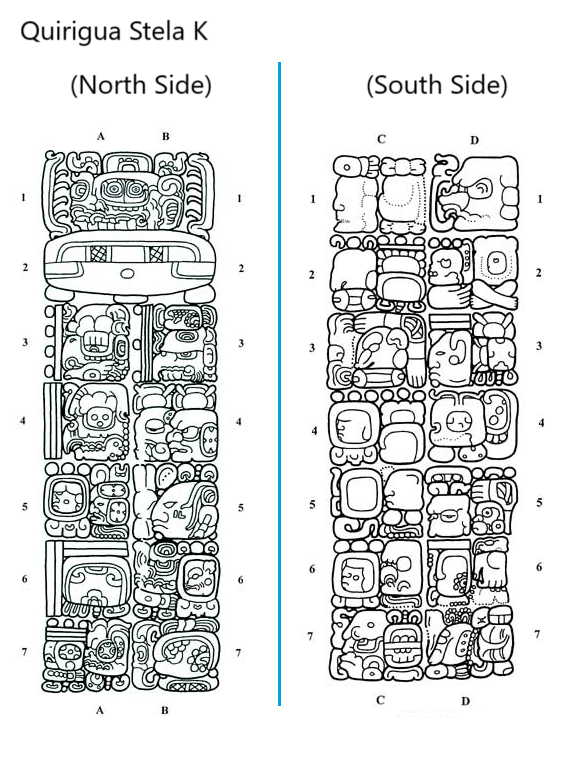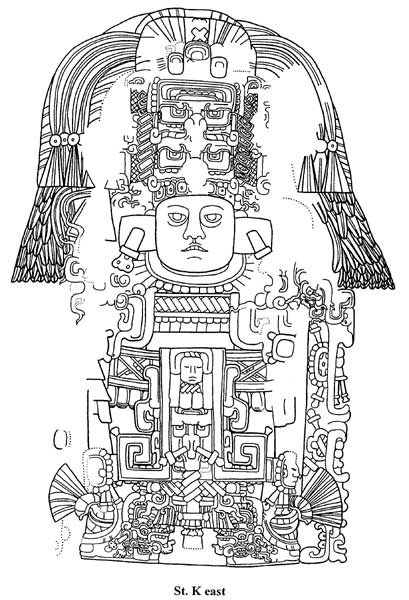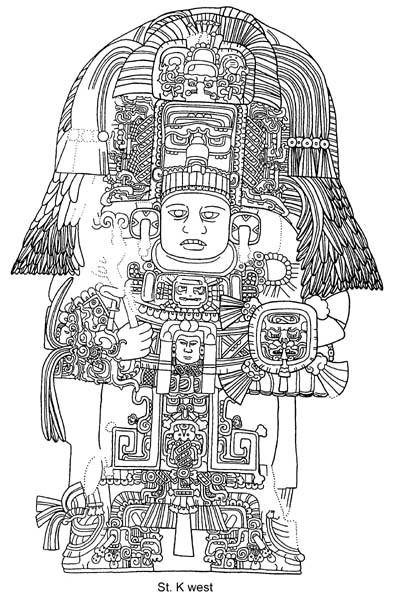[Zoom and scroll to position graphic(s) as desired relative to TTT table at right.]
 |
 |
 |
|
MHD |
| MHD Codes |
Transliteration |
Translation |
|
|
|
North side |
| |
|
A1-B2 |
A1-B2 |
ISIG | ||
|
A3 |
A3 | 9.PIK |
LC = 9.18.15.0.0, … (20 July 805 AD) | |
|
B3 |
B3 | 18.WINIKHAAB |
| |
|
A4 |
A4 | 15.HAAB |
| |
|
B4 |
B4 |
| ||
|
A5 |
A5a | 3:AJAW |
… (on) 3-Ajaw … | |
|
|
A5b | <{y}IHK'IN]>:ni:NAL |
[ç SS starts here Glyph-G9 | |
|
B5 |
B5 |
Glyph-F | ||
|
A6 |
A6 | 10.<10:WINIK:<[ji]ya>> |
[ç 819-day cycle starts here DN = 10.10 (this is 210 days = about 7 months since) | |
|
B6 |
B6a | u:ti:ya |
… it happened … | |
|
|
B6b | 1:OK |
… (on) 1-Ok … | |
|
A7 |
A7a | 18:<[K'AN]a>:si:ya |
… 18-K’ayab [2], … (LC = 9.18.14.7.10; 22 December 804 AD) | |
|
|
A7b |
… he stood … | ||
|
B7 |
B7 |
… (in the) North, … | ||
|
|
|
South side |
| |
|
C1 |
C1a |
… Sak Sip … (white is the colour associated with the North) | ||
|
|
C1b |
… Sim … | ||
|
D1 |
D1 |
… K’awiil, … | ||
|
C2 |
C2a | 1:ch'o:ko |
… Juun Ch’ok [6] … 819-day cycle ends here è] | |
|
|
C2b | 8:HUL:li:ya |
Glyph-DE = it is 8 days into the current lunation | |
|
D2 |
D2a | <<3:DG>.ja>:K'AL |
Glyph-C = it is the 3rd of the 6 lunations governed by the DG | |
|
|
D2b |
Glyph-X = the one corresponding to Glyph-C=4+DG (= mismatch between Glyph-C and Glyph-X) | ||
|
C3 |
C3 | u.<<ch'o:ko>+K'ABA'> |
Glyph-B = (that is) his youth(ful) name | |
|
D3 |
D3a | 10:K'AL |
Glyph-A = there are 30 days in the current lunation SS ends here è] | |
|
|
D3b | 0:<0.WINIK>:<[ji]ya> |
DN = 0.0, … | |
|
C4 |
C4a | 3:AJAW |
(on) 3-Ajaw … | |
|
|
C4b |
… 3-Yax [8], … (LC = 9.18.15.0.0; 20 July 805 AD) | ||
|
D4 |
D4 |
… it stood, … | ||
|
C5 |
C5a | *AJ:ne |
… Ajen … | |
|
|
C5b | ?:*la?:ni |
… <something> … | |
|
D5 |
D5a |
… Uk’ahk’ ?; … (= the name of the stela) | ||
|
|
D5b | u:K'ABA' |
… (it was the) name of … | |
|
C6 |
C6a | 3:AJAW |
… (the) 3-Ajaw … | |
|
|
C6b | TUUN:ni |
… Stone. [11] | |
|
|
|
|
| |
|
D6 |
D6a | 5:<wi{'}.<TUUN:ni>> |
(On the occasion of the start of the) last hotun [12] … (LC = 9.18.15.0.0; 20 July 805 AD) | |
|
|
D6b |
… he scattered incense, … | ||
|
C7 |
C7a | K'AHK'.<ho[lo]{w}> |
… K’ahk’ Holow … | |
|
|
C7b | ya:CHAN:na |
… Chan … | |
|
D7 |
D7a |
… Yopaat, … | ||
|
|
D7b |
… (the) Holy Lord of QRG. | ||
|
|
|
|
|
Introductory Notes
This TTT is based on the following drawings:
QRG - Stela K (north side, glyphs) (Looper-DoSaQ.p14.pdfp14.fig9).
QRG - Stela K (south side, glyphs) (Looper-DoSaQ.p15.pdfp15.fig10).
QRG - Stela K (east side, iconography) (Looper-DoSaQ.p16.pdfp16.fig11).
QRG - Stela K (west side, iconography) (Looper-DoSaQ.p17.pdfp17.fig12).
The north and south sides have glyphic text in the bottom half and iconography in the top half; the east and west sides have only iconography.
Photos:
MHD: Maudslay / Tolles – one of each side, in situ. Available also in the Photos column of the main TTT page of this website: https://mayaglyphs.org/TTTs.html.
A photo of Stela K by Maudslay on site at QRG is also available in Looper-LW.p197.pdfp210.fig6.18 (“further reproduction prohibited”).
A Sketchfab 3D model is also available.
There’s a similar set of drawings, also by Looper, in Looper-QaGtaAMC (Quirigua: A Guide to an Ancient Maya City (Looper; 2007)) p. 127-128, fig. 4.19, 4.20. The latter drawings are used in MHD. There are subtle but significant differences between the two sets. For example:
D1:
The flames of K’awiil on the left:
Looper-DoSaQ: has only a single scroll going up, curling to the left at the top.
Looper-QaGtaAMC: has a scroll going up which divides into two at the top.
The ear of K’awiil on the right:
Looper-DoSaQ: has a circle as the middle of the three elements.
Looper-QaGtaAMC: has a “washer” as the middle of the three elements.
C3:
The ear of the rat-head variant of ch’o in uch’ok k’aba’:
Looper-DoSaQ: has a “single hump” internal line as reinforcement of one part of the ear.
Looper-QaGtaAMC: has a “w-like” internal line as reinforcement of one part of the ear.
Sources used:
Looper-DoSaQ (Documentation of Sculptures at Quiriguá, Guatemala (Looper; 2001)): Source of drawings used for the TTT.
This TTT has been cross-checked against the MHD TTT (“objabbr = QRGStK”).
Although there’s only one system of glyph-block labelling, there are two columns showing the labels because my TTT splits up many more glyph-blocks into -a and -b than the MHD system. For this inscription, MHD doesn’t split any of the glyph-blocks, whereas I split almost all of them.
The glyphic text of the north and south sides forms a single continuous narrative, with only one ISIG and explicit LC, given at the start of the inscription on the north side.
Some of the coefficients of the SS don’t match what is expected from the ISIG’s LC.
In almost all inscriptions with an ISIG and LC, the first recounted event – on the date of the ISIG’s LC – is simply recounted, without a DN. One unusual aspect of this inscription is the explicit writing of a DN of 0.0, with a slightly different syntax than normal (see end note under C4).
Summary:
This inscription recounts the hotun period ending in 805 AD (9.18.15.0.0) as commemorated in QRG.
The immediately preceding 819-day cycle station is mentioned.
The non-generic name of this stela (Stela K) is given, though the name itself is unclear.
The QRG ruler’s scattering of incense as part of the commemoration ritual (presumably around said Stela) is also recounted.
The name of the QRG ruler in question is K’ahk’ Holow Chan Yopaat (see end note under C7-D7):
He’s known from QRG Stela I as K’ahk’ Jolow Chan Yopaat, where he’s mentioned in connection with the immediately preceding half-katun period ending, in 800 AD (9.18.10.0.0). The slight difference in the two spellings is probably due to the collapse of the h/j distinction in the Late Classic.
Do not confuse this name with Jolow Chan K’awiil, an additional name/title of one of this ruler’s predecessors, K’ahk’ Tiliw Chan Yopaat.
He’s known in M&G.p218.pdfp218.#3 (and in much of the academic literature) as “Jade Sky”, who reigned >800 - 810 AD.
[1] A1-B2. The LC HAAB-month is YAX, whose patron EK’ matches the patron infixed in the ISIG. This infixed patron seems to be EK’ infixed in the “Venus Monster”.
[2] B6b-A7a. Calendrical calculations:
 +
+ ![]() =
= 
LC = 9.18.14.7.10; 22 December 804 AD.
The previous CR - DN matches the current CR.
[3] A7b.
|
|
|
<<WA’+OK?>[ja]>:<[la]ya> |
The element over the eye is simply a form of the CHUWEN-/se-/cha-like element covering the eye of the animal head – a distinctive characteristic of WA’.
The ja of la-ja-ya è -lajiiy seems to be infixed in the WA’, making the reading order a bit at odds with the arrangement of the glyphs. What this isn’t is WAL being a transitive verb, with the la being just an end phonetic complement and the ja contributing to the <verb-stem>-h-l-ja, making *wahlaj, the passive form of wal. Instead, this is WAL/WA’ as a positional verb, with a -laj-iiy inflection, where the -laj is similar to chumlaj, with chum being another positional verb.
MHD reads a (y)OK = “foot (of)” which could be the dog-head (MHD.AP1) conflated with the more bird-like head of WA’ (MHD.AX1). This is a known but optional part of the 819-day cycle expression – such a reading perhaps being prompted by the teeth in the animal head.
· WA’ is a positional verb. EB.p196.pdfp201.#2: wa’ pv. “to put upright”, “to erect”. As this category doesn’t exist in English, they are often translated with “to be” + “past participle”, e.g., chum = “to be seated”. This then tends to give them a feeling of being a passive form of a transitive verb, but they are certainly not that in Classic Maya. Instead, they reflect a situation where an object or person occupies (or takes) a certain physical position, with respect to the surroundings. So they should feel more like an intransitive or stative verb. MHD gives “stand up” in the Catalog, and “stood” for QRG Stela K A7a, which nicely leaves more open the question of transitivity or otherwise (and hence avoids the “passive” feeling).
[4] B7.
|
|
|
B7 <NAAH/na>.<hi:li> |
It’s very easy to think that this is utuunil = “the stone/stela of”, but that leaves the “knot” at the top of B7b unexplained. MHD reads NAAH at B7a. Reading NAAH-hi-li/na-hi-li è nahil = “north” explains both the “knot” and provides a compass direction which is common in the 819-day cycle expression at this point. How this relates to the two commonly listed words for “north” – xaman (Classic) and nal (Post-Classic) is unclear to me. Perhaps nal is a contraction of nahil.
[5] C1.
|
|
|
<SAK:*SIP?>.*SIM |
The head-glyph at the bottom of C1a is very eroded. The SIP is from MHD and is perhaps read from context (this being the only word which fits in this spot). The SIM at C1b, though also very eroded, can be read with confidence because it’s expected in conjunction with the SIP, but also because the two bent arms can be discerned at the top and the two bent legs at the bottom.
[6] C2a. Juun Ch’ok is a known optional part of the 819-day cycle statement.
[7] D2b. Glyph-X.
This is simply the “ECLIPSE-GLYPH” above and the “CROSSED-LEGS” below, one of the known forms of Glyph-X.
[8] C4. Calendrical calculations.

LC = 9.18.15.0.0; 20 July 805 AD.
Unusually, the 3-Ajaw from before the SS (A4a) is repeated here, after the SS (C5a).
SS cross-checks:
- The variant of Glyph-G and the values of the various coefficients of the SS as calculated by the Villaseñor calendar program can be cross-checked against what appears in the inscription.
- The variant of Glyph-X as it appears on the inscription can also be cross-checked against the coefficient and ruling god of Glyph-C.
|
SS |
Program |
Inscription |
|
|
Glyph-G |
G9 |
G9 |
ü |
|
Glyph-DE |
19 |
8 |
û |
|
Glyph-C |
3 |
3 |
ü |
|
Glyph-X |
n/a |
For Glyph-C=4+DG |
Actual Glyph-C=3+DG so there is a mismatch between Glyph-X and Glyph-C. |
|
Glyph-A |
29 |
30 |
û |
That only 2 out of the 5 values match is disappointingly low. It remains a mystery to me why these SS cross-checks so often reveal a number of discrepancies.
[Sim’s very speculative musings: A mismatch in Glyph-A might be more due to epigraphers not fully understanding the correct method of calculating the theoretical value than to “mistakes” made on the part of the calendrical experts, designers or carvers of the time of the creation of the monument. For example, the modern algorithm might take the number of days in each of the 6 lunations as 29, 30, 29, 30, 29, 30 (or 30, 29, 30, 29, 30, 29) – which might have been true in general over the whole Maya region – whereas the “local standard” might have been 29, 29, 29, 30, 30, 30 (or 30, 30, 30, 29, 29, 29).]
Note the unusual feature of having DN = 0.0. Normally, after the ISIG, we have the LC, Tzolk’in date, SS, Haab date, optional locative phrase, then the verb of the first recounted event, i.e., the event associated with the ISIG LC, without a DN. It’s only after this first recounted event that we get a (“non-zero”) DN, which takes us to the next CR, associated with the second event recounted after the ISIG.
Here however, instead of the Haab date, we have a DN = 0.0, and a full CR, i.e., a repetition of the previously given Tzolk’in date, with the appropriate Haab date. There’s no flaw in the logical or mathematical aspects of this, it’s just slightly different from the standard pattern (and the only such one I’ve seen so far).
[9] D4. As in A7b, this is wa’laj with wa’ as a positional verb and not wahlaj, with an inserted -h- and -aj as the passive of a transitive verb wal.
[10] C5-D5a.
|
|
|
|
|
C5 D5a <*AJ?:ne>.<?:*la?:ni?> <u:K’AHK’?:?> |
|
TOK.p32.pdfp32.r4.c1 (“flaming AK’BAL”) AJ |
This reading is adapted from MHD:
· C5a (top): MHD reads/reconstructs this as AJ – apparently the “flaming AK’BAL”, rotated 90 degrees anticlockwise.
· C5a (bottom): MHD reads ne.
· C5b (top): MHD does not attempt to read this head-glyph.
· C5b (middle): MHD reads the two circles as la?.
· C5b (bottom): MHD reads ni (no question mark).
· D5a: MHD reads the middle element as the reduced variant of K’AHK’ with the bottom element unknown. [Sim: The u- however tends to suggest that the eroded head is a noun or proper noun, the “possessor” of the fire. This makes the reading of the middle element as the reduced variant of K’AHK’ quite likely. However, perhaps the possibility of the middle and bottom elements forming a single logogram shouldn’t be excluded.]
The context (with uk’aba’ hux-ajaw tuun following) suggests that this is the name of the stela.
[11] C6. The stela is called the “3-Ajaw Stone” because it was raised on 3-Ajaw.
[12] D6a. 9.18.15.0.0 is indeed the start of the last hotun of the 18th katun.
[13] D6b.
|
|
|
D6b u:CHOK:*ch’a{aj} |
The reading *ch’a?{aj} è ch’aaj is adapted from MHD and is probably based on context (ch’aaj being the most common object of CHOK). Could it be that the eroded element at the bottom isn’t ch’aaj, but instead wa, to make uchokow, with just an implicit object “he scattered it (=incense)”?
[14] C7-D7.
|
|
|
C7-D7 <K’AHK’.<ho[lo]>>.<ya:CHAN:na> <<yo.<YOPAAT+AT>>:ti>.<<K’UH{ul}.“TOL”>:AJAW:wa> |
The reading ho-lo-ya è holow is from MHD. The unusual treatment of ya is perhaps because the name K’ahk’ Holow Chan Yopaat (as a ruler of QRG) is known from other QRG inscriptions.
The name Holow is known (with wo instead of ya) (e.g., from Looper-LW.p198.pdfp211.fig6.19) on:
· QRG Structure 1B-1 Hieroglyphic Step D-F.
· QRG Structure 1B-1 Hieroglyphic Step Q-R.
and one instance of Jolow on:
· QRG Stela I A8-B8
|
|
|
Looper-LW.p198.pdfp211.fig6.19.l+1 QRG Structure 1B-1 Hieroglyphic Step D-F K’AHK’.<<ho[lo]>:wo> <CHAN:na>.<<YOPAAT+AAT>:ti> <K’UH:K’UH{ul}>.<“TOL”:AJAW:*wa> ba.<ka:ba> |
|
|
|
Looper-LW.p198.pdfp211.fig6.19.l+3 QRG Structure 1B-1 Hieroglyphic Step Q-R K’AHK’.<<<ho[lo]>:wo>:CHAN>:na> <<YOPAAT+AAT>:ti>.<ba:ka:ba> |
|
|
|
Looper-DoSaQ.p11.pdfp11.fig6 QRG Stela I A8-B8 <<K’AHK’.jo[*lo{w}]>>.<na.<CHAN:na:<ni?/wi?>>> <yo.YOPAAT>+<AAT:ti> |
The transcription of Holow rather than (something like) Holoy might be due to “statistics”, with two known (and a third highly likely) instances of -w and only one of ‑y. This may or may not be supported by the existence of potential descendants in the modern and Colonial Mayan languages for the former, but I’m unaware of where this might have been discussed.



